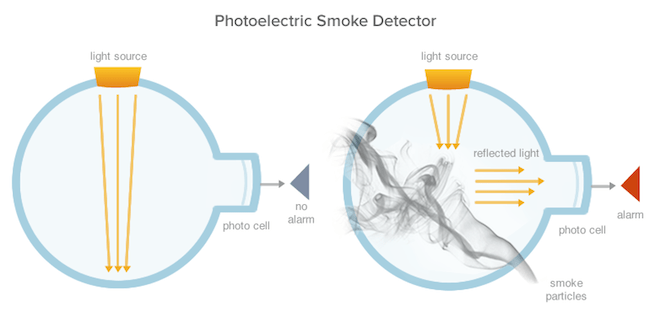Could you explain how photoelectric smoke sensors work and how this compares to ionising sensors? Which is considered the more reliable technology? What additional features are worth considering for smoke alarms?
A: Before we go further, Consumer NZ has removed ionising smoke sensors from sale, the US government has introduced smoke sensor tests that preclude ionising sensors and Australian fire authorities make mandatory PE smoke sensors in hotels, hospitals, schools and more. For this reason, we recommend photoelectric smoke sensors for professional security applications.
The contention around ionising sensors is their ability to detect smouldering fires quickly – it can take them up to 60 minutes to go into alarm, according to research. As well as activating more quickly in the presence of smoke, photoelectric smoke sensors are less susceptible to false alarms generated by cooking fumes.
Photoelectric sensor types can use a photoelectric cell and an external light source, with a reduced light threshold at the sensor used as the alarm point. Given the nature of operation, it’s important to keep light source lens and sensor lens clean with iso alcohol. Other PE sensors have a light source that takes a circuitous route through a labyrinth, with reductions in the smaller amount of light reaching the sensor generating a more sensitive alarm.
It’s generally accepted that ionising sensors are better at detecting flames, as the process of vigorous combustion generates particles that are ionised when they reach the sensor, generating an alarm. But the recommendations of fire authorities to use PE sensors should be adhered to and it’s worth bearing in mind that ionising sensors contain radioactive material that ends up as landfill that leaches into the water cycle.
If there are ionising sensors in a home already, they could be relocated where flaming fires are most likely to occur, but PE sensors should also be installed and are a must for sleeping areas. There are dual technology sensors that employ both sensor types, and these may be the choice in some applications. At all times, security installers should ensure sensors conform to Australian Standard for smoke alarms, AS 3786:2014.
Additional features that would be beneficial include integrated lighting to assist escape, a hush button so nuisance alarms can be quieted, a battery test function, a long life battery (10 years), and depending on the user, you may need to include a strobe so hearing impaired users can be alerted to fire danger.
#sen.news











